There is every reason to cultivate and consume indigenous Philippine vegetables. They’re resilient, incredibly nutritious, sustainable, and nothing short of flavorful. Because they’re resistant to pests and diseases, they play a crucial role in food security. Alas, they’re often underutilized and underappreciated in favor of imported crops.
So, in this article, I invite you to explore the top native Philippine vegetables, their nutritional benefits, and their culinary properties.
But before that, let’s define what makes a vegetable indigenous: Philippine indigenous vegetables are vegetable species that are native to the country or have been cultivated here for a long time. As a result, they have adapted to the local climate, soil, and growing conditions that they became a part of the traditional culture, diet, and regional cuisines.
Please note that while these vegetables are indigenous to the Philippines, some of them are also native to other regions. For example, okra and taro are indigenous to Africa but have been cultivated in the Philippines for so long that they are considered local vegetables. Similarly, sayote is native to Latin America, but it is widely grown and consumed in the Philippines.
And now, I present to you the top indigenous vegetables of the Philippines.
1. Talinum (Jewels of Opar)
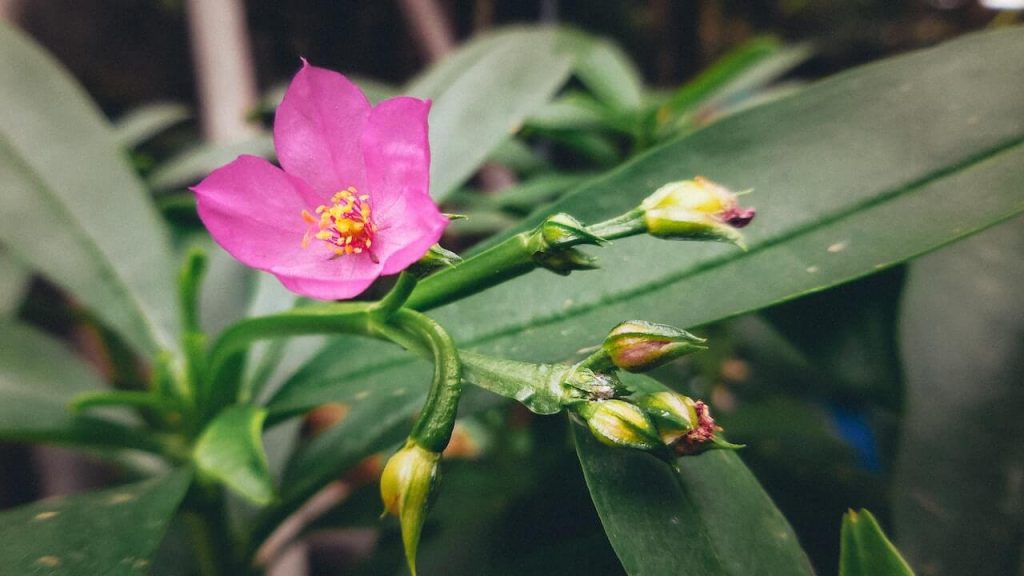
Talinum, known locally as Talinum and internationally as Jewels of Opar, is a tropical plant bearing plump leaves and delicate pink flowers. It’s a resilient, leafy plant native to the Philippines that can grow under various conditions.
Talinum is a gold mine of nutrition. It’s packed with vitamins A and C, calcium, phosphorus, and iron. This makes it a great addition to a balanced diet, promoting overall health.
Talinum’s taste is mild, with a slightly peppery note similar to watercress. Its succulent leaves have a pleasing crunch. Here are some dishes where Talinum shines:
- Talinum Salad: A simple yet delicious salad featuring Talinum leaves tossed with tomatoes, onions, and a light vinaigrette.
- Talinum Stir-fry: In this dish, Talinum leaves are stir-fried with garlic and onions, creating a delightful side dish.
- Talinum Soup: A comforting dish where Talinum is boiled into a clear soup, offering a clean, refreshing taste.
- Talinum with Scrambled Eggs: An interesting breakfast dish where the fresh leaves are mixed with scrambled eggs, adding a healthful touch to the morning meal.
- Talinum in Coconut Milk: A creamy dish where Talinum leaves are cooked in coconut milk, providing a mix of rich and fresh flavors.
2. Pako (Fiddlehead Fern)
Pako, also known as Fiddlehead Fern, is a type of fern that’s harvested for its young, tender shoots. The name ‘fiddlehead’ comes from their distinctive spiral shape that resembles the head of a fiddle.
Pako is highly nutritious, boasting high levels of vitamin A, vitamin C, and iron. It also provides dietary fiber, making it a beneficial addition to your diet.
The taste of Pako is slightly nutty and grassy, with a unique crunchy texture. Here are some dishes that incorporate Pako:
- Pako Salad: A refreshing salad where blanched Pako is tossed with tomatoes, onions, and a sweet-sour vinaigrette, making it a popular dish among Filipinos.
- Pako and Shrimp Stir-fry: A delightful dish where Pako is stir-fried with shrimps, garlic, and a touch of oyster sauce, creating a harmony of flavors.
- Pako Soup: A light and nutritious soup where Pako is the star, paired with miso or chicken broth for a comforting meal.
- Pako and Egg Stir-fry: An easy and healthy dish where Pako is sautéed with scrambled eggs, perfect for a quick meal.
- Pako in Coconut Milk: A creamy, rich dish where Pako is cooked with coconut milk, chili, and shrimp paste, offering a balance of flavors.
3. Sitsaro (Snow Peas)
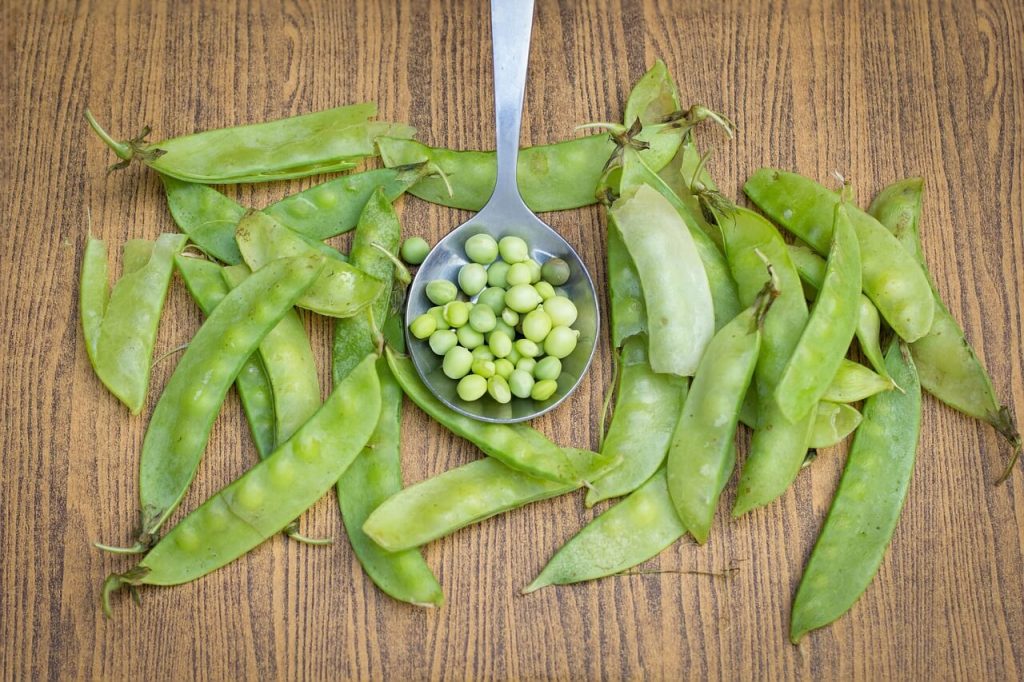
Sitsaro, also known as Snow Peas, are flat, tender pods with tiny peas inside. These edible pods are a staple in Filipino and Asian cuisines. They are harvested early, so the peas are small and the pod is still flat.
Snow peas are low in calories and high in fiber, vitamin C, and vitamin K. They are also rich in iron and contain a decent amount of proteins for a vegetable.
Sitsaro has a fresh, sweet taste and a crispy texture. The peas inside are tender and slightly sweet, adding a burst of flavor with every bite. Here are some dishes that include Sitsaro:
- Sitsaro Guisado: This dish features Sitsaro stir-fried with garlic, onions, and tomatoes, and sometimes with tofu or pork for added flavor.
- Sitsaro and Carrot Salad: A fresh and crunchy salad where Sitsaro and carrot strips are tossed with a light sesame dressing.
- Chopsuey with Sitsaro: Sitsaro is one of the many vegetables included in this popular Filipino stir-fry dish.
- Sinigang with Sitsaro: In this traditional Filipino sour soup, Sitsaro adds a sweet note and a crispy texture to the mix of vegetables and tamarind broth.
- Sitsaro and Shrimp Stir-fry: A delicious stir-fry where Sitsaro is cooked with shrimp and a soy-based sauce, offering a delightful mix of flavors and textures.
4. Kulitis (Amaranth Leaves)
Kulitis, or Amaranth Leaves in English, is a type of leafy green widely used in Filipino cuisine. These leaves come from the Amaranth plant, which is known for its colorful flowers. Interestingly, not only are the leaves edible, but also the seeds, which are used as a grain similar to rice or quinoa.
Kulitis is a nutrient-dense vegetable. It’s packed with vitamins A, C, and K, as well as calcium, iron, and protein. The seeds of the plant are also a good source of protein and fiber.
Kulitis has a slightly sweet and earthy flavor, somewhat similar to spinach. Here are some dishes that include Kulitis:
- Adobong Kulitis: A variation of the Filipino adobo where Kulitis leaves are cooked with soy sauce, vinegar, and garlic, yielding a savory and tangy dish.
- Kulitis Salad: A fresh salad where raw Kulitis leaves are tossed with tomatoes, onions, and a tangy vinaigrette, bringing out the leaves’ natural sweetness.
- Kulitis and Egg Stir-fry: A simple and nutritious dish where Kulitis is sautéed with scrambled eggs, making for a quick and healthy meal.
- Kulitis Soup: A comforting soup where Kulitis is simmered with ginger and a variety of other vegetables, creating a nourishing and flavorful broth.
- Kulitis in Coconut Milk: A rich dish where Kulitis is cooked in coconut milk, chili, and shrimp paste, offering a wonderful balance of flavors.
Integrating Kulitis into our meals helps us to embrace the diversity of local vegetables. Its unique taste and versatility add a new dimension to our dishes. Plus, it reminds us of the importance of sustainable food practices, as it is a native vegetable that supports our local farmers.
5. Malunggay (Moringa)
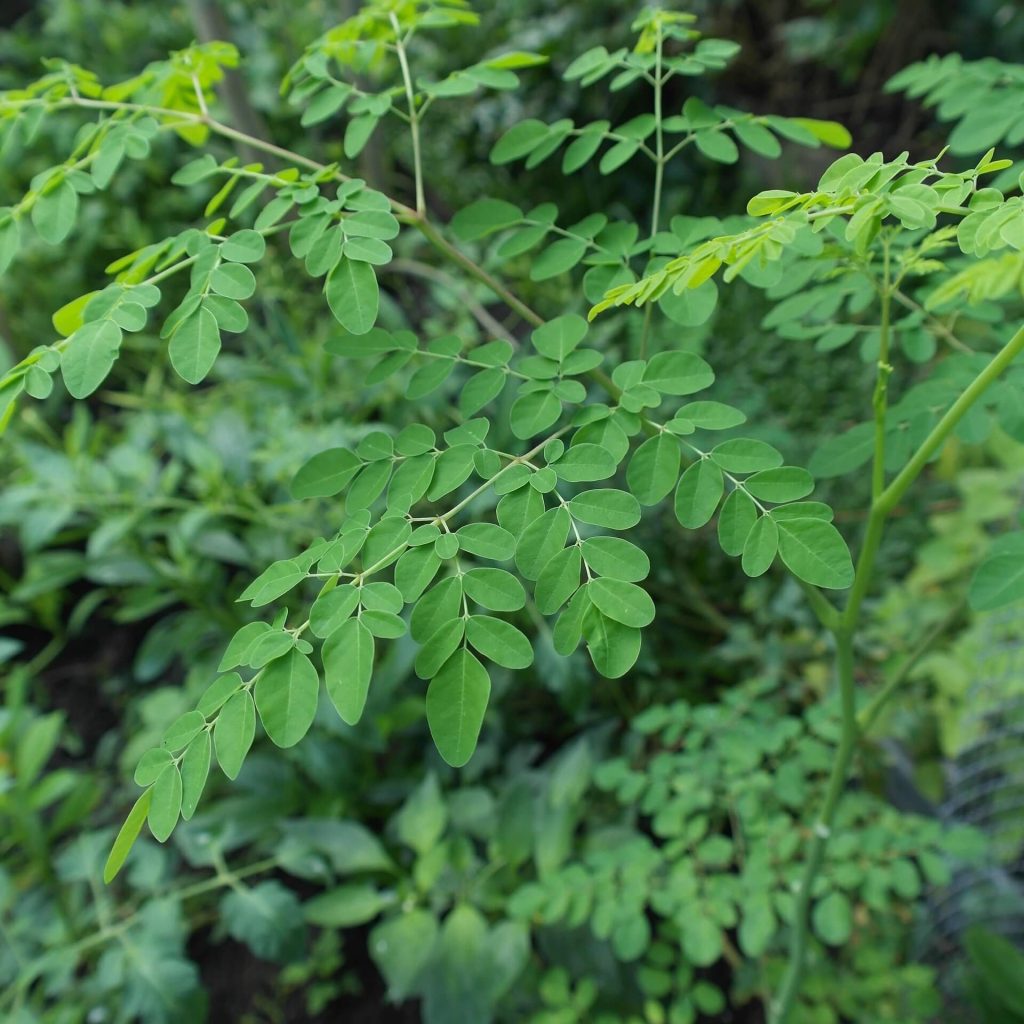
Malunggay, also known worldwide as moringa, is a fast-growing, drought-resistant tree known for its small, round leaves. Despite its humble appearance, Malunggay is a nutritional powerhouse, loaded with vitamins A, B, and C, calcium, iron, and protein. It’s also high in antioxidants, which have been linked with various health benefits.
Malunggay leaves have a unique, slightly peppery flavor that enhances the taste of various dishes. Some of these dishes include:
- Tinola: This comforting Filipino chicken soup with a clear ginger-flavored broth is enriched by Malunggay leaves, adding a hint of peppery flavor and loads of nutrients.
- Malunggay Pandesal: A variation of the popular Filipino bread roll, where the dough is mixed with Malunggay leaves, adding a nutritional boost and a unique flavor to this bakery staple.
- Chicken Afritada with Malunggay: A hearty tomato-based chicken stew gets a nutritional upgrade with the addition of Malunggay.
- Malunggay Juice: A refreshing, healthy drink made from fresh Malunggay leaves, often sweetened with honey or sugar, providing a nutrient-dense and revitalizing beverage.
- Malunggay Pesto: A Filipino spin on the classic Italian sauce, where Malunggay leaves replace the traditional basil, resulting in a vibrant and nutrient-packed sauce perfect for pasta or as a spread.
6. Gabi (Taro)
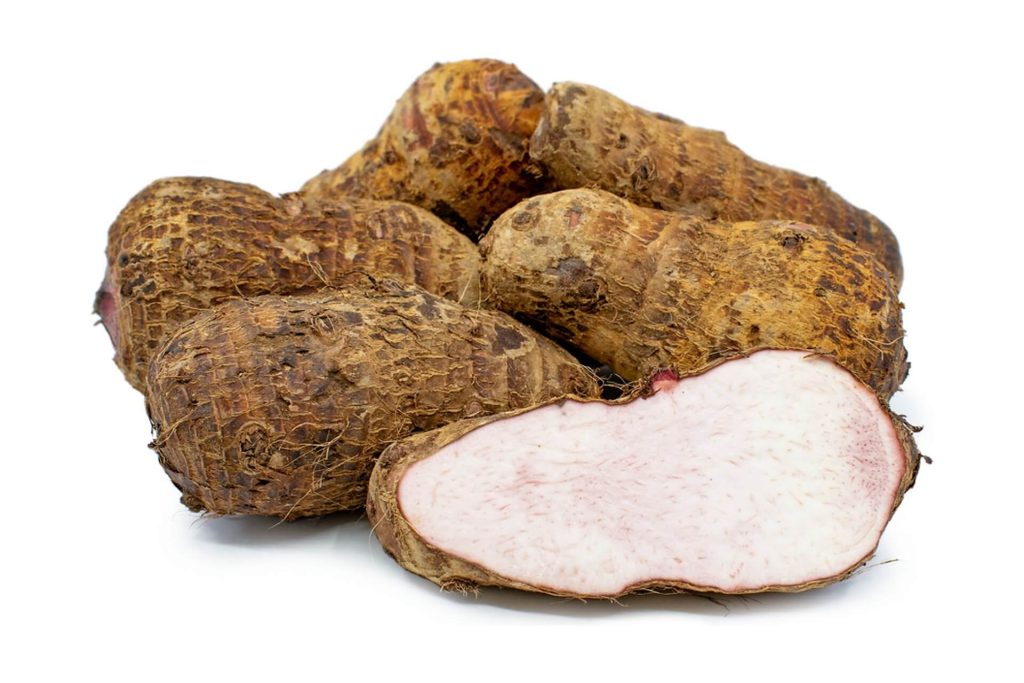
Gabi, or Taro, is a versatile root vegetable that is well-suited to the country’s wet and humid climate. Both its large, heart-shaped leaves and its roots are edible.
Gabi is a great source of dietary fiber, which aids digestion, and is also rich in vitamins A and C, calcium, and potassium. Its roots are particularly high in starch, making them an energy-dense food.
The taste of Gabi is subtly sweet and slightly nutty, while its texture is starchy and creamy when cooked. Here are some dishes featuring Gabi:
- Laing: In this Bicolano dish, dried Gabi leaves are simmered in coconut milk and chili peppers, creating a creamy, spicy, and satisfying dish.
- Sinigang: Gabi is often added to this sour soup, as its starchy texture helps thicken the broth.
- Ginataang Gabi: A dessert where Gabi is cooked in sweetened coconut milk, highlighting its sweet and nutty flavor.
- Gabi Ice Cream: An unconventional dessert where the subtly sweet and starchy Gabi is turned into a creamy ice cream.
- Gabi Chips: A healthy alternative to potato chips where Gabi is sliced thinly, deep-fried until crispy, and sprinkled with salt.
7. Takway (Taro Vine)
Takway, also known as Taro Vine, is a tropical plant widely cultivated in the Philippines. The leaves and the roots of the plant are both edible and used in various dishes.
Takway is rich in dietary fiber, vitamin C, vitamin E, vitamin B6, and magnesium. The plant is also high in antioxidants, which can help the body fight off damaging free radicals.
Takway’s taste is similar to spinach but slightly sweeter. Here are some dishes that use Takway:
- Takway Salad: This is a simple salad where blanched Takway is tossed with tomatoes, onions, and a light vinaigrette dressing.
- Adobong Takway: In this dish, Takway is sautéed with soy sauce, vinegar, and garlic, making for a tasty variation of the classic adobo.
- Takway in Coconut Milk: Takway is simmered in rich coconut milk with a hint of chili, creating a creamy and slightly spicy dish.
- Sinigang with Takway: This sour soup features Takway among its medley of vegetables, giving an interesting texture and a subtle sweetness.
- Takway and Mung Bean Soup: A hearty soup where Takway and mung beans are cooked together, offering a comforting meal with earthy flavors.
8. Patola (Luffa)
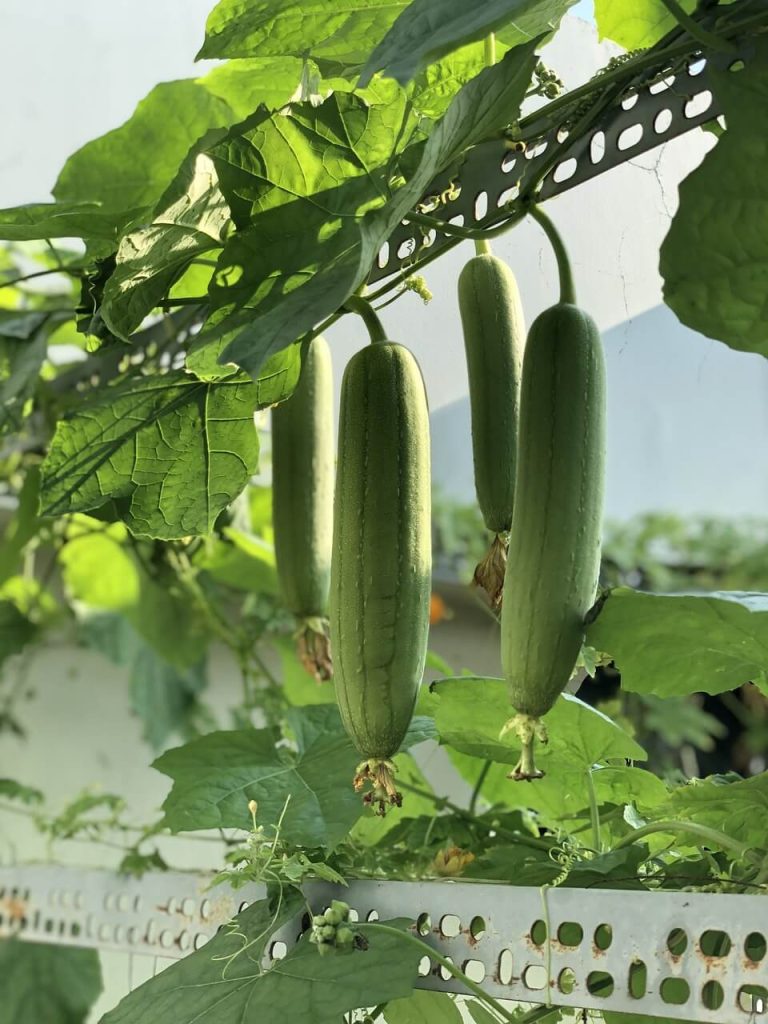
Patola, also known as Luffa or Sponge Gourd, is a tropical and subtropical vine of the cucumber family. It is best harvested young and tender to be used as a vegetable.
Patola is a good source of vitamins A and C, provides dietary fiber, and is also low in calories, making it a healthy addition to many dishes.
Patola has a mild, slightly sweet taste, and a sponge-like texture when cooked. Here are some dishes that feature Patola:
- Misua Patola Soup: A simple, comforting soup where Patola is cooked with misua noodles and a light, savory broth.
- Ginisang Patola: A quick stir-fry where Patola is sautéed with ground pork and shrimps, highlighting its mild flavor.
- Patola and Egg Soup: A comforting soup where Patola is cooked with beaten eggs in a flavorful broth.
- Patola with Misua and Meatballs: A hearty dish where Patola is paired with tender meatballs and delicate misua noodles in a light broth.
- Pickled Patola: In this dish, slices of Patola are pickled in a vinegar mixture, resulting in a crunchy and tangy condiment.
9. Saluyot (Jute)
Saluyot is a vibrant green leafy vegetable that flourishes even in poor, drought-prone soils. This plant is a trove of vitamins A, C, and E, iron, and calcium. It also offers dietary fiber, which aids digestion. When it comes to taste, Saluyot has a slightly bitter note. Its distinctive flavor adds a unique layer to many dishes. Some notable ones include:
- Dinengdeng: This traditional vegetable stew from the Ilocos region features Saluyot, which adds a hint of bitterness and a unique texture to the fermented fish sauce.
- Bulanglang: A light soup from Batangas, where Saluyot contributes its slightly bitter taste and silky texture to a medley of mixed vegetables in a shrimp paste base.
- Adobong Saluyot: A unique variation of the famed Filipino adobo, where Saluyot leaves are sautéed with soy sauce, vinegar, and garlic, bringing a fresh taste to this classic dish.
- Saluyot Salad: A refreshing salad where the blanched leaves are tossed with tomatoes, onions, and a light dressing, perfect for a hot summer day.
- Saluyot Pancake: A twist on the classic pancake, where the leaves are mixed into the batter, adding a mild bitterness and an extra dose of nutrients to this breakfast favorite.
10. Katuray (Sesbania Flower)
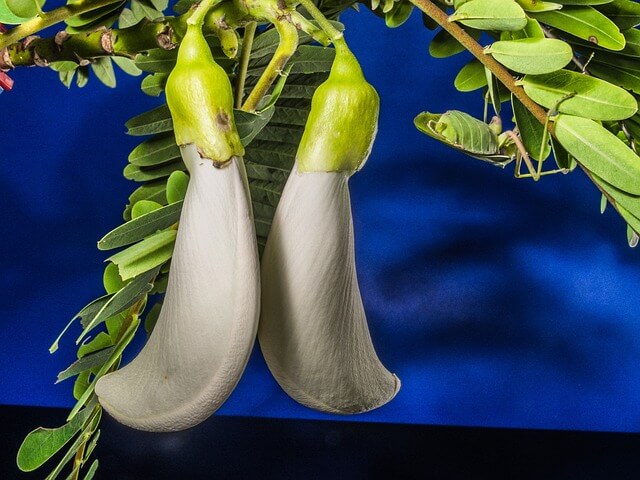
Katuray, also known as Sesbania Flower or Agati, is a white or light violet flower that is commonly consumed in the Philippines. This unique edible flower comes from the Sesbania grandiflora tree.
The Katuray flower is a good source of calcium and fiber and also provides essential vitamins like vitamins A and C. It is also known to have medicinal properties, including anti-inflammatory effects.
The Katuray flower has a slightly bitter taste, which is often complemented by other flavors in the dish. Here are some Filipino dishes that incorporate Katuray:
- Katuray Salad: This refreshing salad features blanched Katuray flowers mixed with tomatoes, onions, and a tangy vinaigrette.
- Katuray and Ampalaya Salad: In this dish, Katuray is combined with the slightly bitter ampalaya, with the flavors balanced by a zesty dressing.
- Adobong Katuray: A unique version of the classic Adobo, where Katuray flowers are sautéed with soy sauce, vinegar, and garlic.
- Katuray Omelette: This breakfast dish involves Katuray flowers mixed into an egg batter and fried until golden.
- Sinigang with Katuray: Katuray is added to the traditional Filipino sour soup, lending its unique flavor to the mix of vegetables and tamarind broth.
11. Upo (Bottle Gourd)
Upo, or Bottle Gourd, is a vine plant that produces large, bottle-shaped fruits that are commonly used as a vegetable in Filipino cuisine. The smooth, light green skin encloses a white, mild-tasting flesh that absorbs flavors well.
Upo is low in calories but high in fiber. It also provides some vitamin C, potassium, and calcium. Eating Upo can help hydrate the body due to its high water content.
The taste of Upo is quite mild, making it a great base for many dishes. It’s also subtly sweet and mildly earthy. Here are some dishes featuring Upo:
- Ginisang Upo: A simple stir-fry dish where Upo is sautéed with garlic, onions, and tomatoes.
- Upo with Misua: A comforting soup where Upo is cooked with misua (fine wheat noodles) and seasoned with patis (fish sauce).
- Upo with Sotanghon: Another noodle dish where Upo is cooked with sotanghon (glass noodles) and a variety of other ingredients.
- Upo with Shrimp: A delectable stir-fry where Upo is cooked with shrimps and a savory sauce.
- Upo and Egg Stir-fry: A quick and easy dish where Upo is stir-fried with eggs, offering a delightful contrast of textures.
12. Ampalaya (Bitter Gourd)
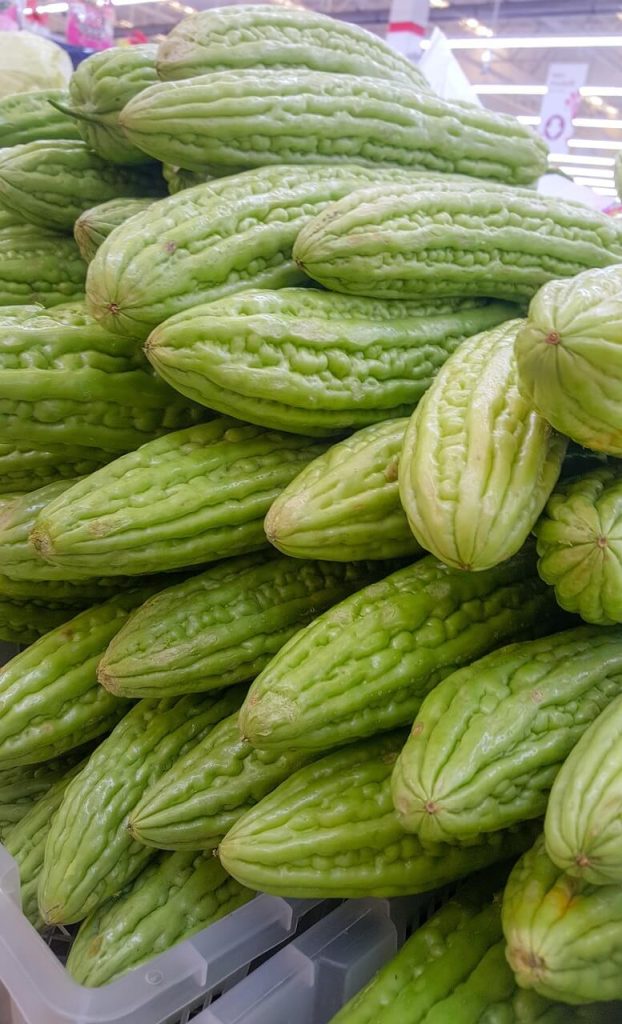
Ampalaya, also known as Bitter Gourd or Bitter Melon, is an edible fruit that’s usually consumed as a vegetable. As the name suggests, it’s well-known for its bitter taste, which is often an acquired preference.
Ampalaya is packed with vitamins C, A, E, and B-complex, and provides important minerals such as iron, potassium, calcium, and magnesium. It’s also a rich source of dietary fiber. Notably, it has been used in traditional medicine for its potential to regulate blood sugar levels.
Ampalaya has a very distinctive bitter taste that can be tempered with cooking. Here are some dishes that feature Ampalaya:
- Ampalaya con Carne: Beef and Ampalaya are stir-fried in a savory oyster sauce, with the beef’s richness balancing the vegetable’s bitterness.
- Pinakbet: In this mixed vegetable stew, Ampalaya adds a layer of complexity with its unique bitter flavor.
- Ampalaya Salad: A simple salad where thinly sliced Ampalaya is blanched and tossed with tomatoes, onions, and a tangy dressing.
- Ginisang Ampalaya: A stir-fried dish where Ampalaya is sautéed with eggs and tomatoes, taming its bitterness.
- Ampalaya with Shrimp (Ginisang Ampalaya at Hipon): A dish where the bitterness of Ampalaya is contrasted with the sweet and salty flavor of shrimps.
13. Ampalaya leaves (Bitter Melon Leaves)
Bitter Melon Leaves, or Ampalaya Leaves, are commonly used in Filipino cuisine. They’re the leafy part of the Bitter Melon plant, also known for its distinctively bitter fruit.
Ampalaya Leaves are packed with nutrients. They’re high in vitamins A and C and provide iron, magnesium, and potassium. They’re also known for their potential health benefits, such as lowering blood sugar levels.
These leaves have a slightly bitter taste, which can be minimized by proper cooking. Here are some dishes that feature Ampalaya Leaves:
- Ampalaya Leaves Salad: The leaves are blanched, then tossed with tomatoes and onions in a light vinaigrette, offering a nutrient-packed side dish.
- Ampalaya Leaves with Egg: This dish features sautéed Ampalaya Leaves scrambled with eggs, adding a creamy balance to the leaves’ bitterness.
- Ampalaya Leaves Soup: A comforting soup where Ampalaya Leaves are cooked with garlic and onions, perfect for rainy days.
- Ampalaya Leaves in Coconut Milk: Here, Ampalaya Leaves are cooked in rich coconut milk with chili and spices, a creamy dish with a hint of heat.
- Ampalaya Leaves and Mung Bean Soup: A hearty soup where Ampalaya Leaves are cooked with mung beans, offering a balanced blend of flavors.
14. Puso ng Saging (Banana Blossom)
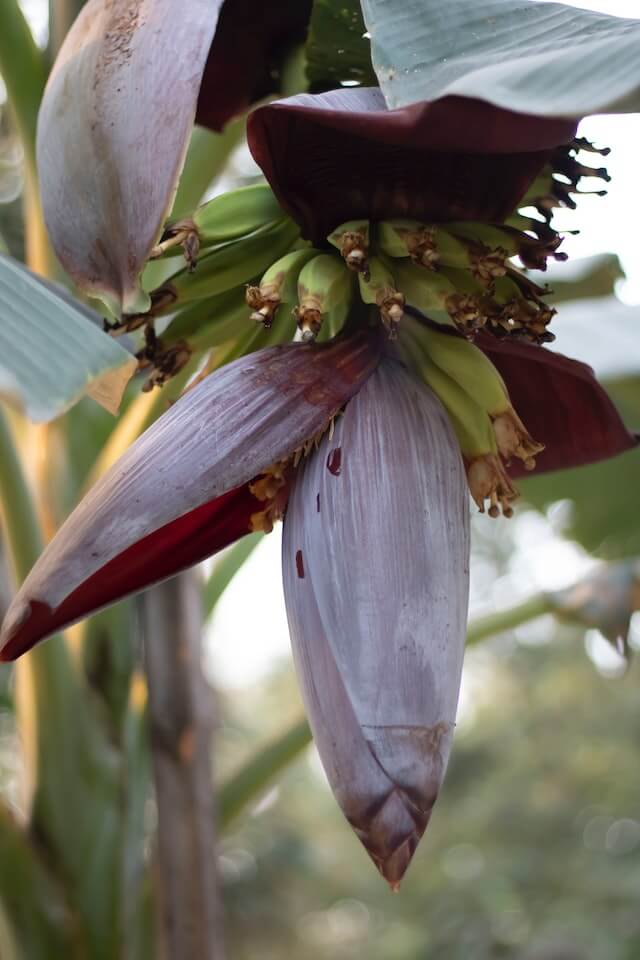
Puso ng Saging, or Banana Blossom, is the flower of the banana plant and is considered a vegetable in Filipino cuisine. It has a dark purple outer layer, with softer, paler florets inside.
Banana Blossom is an excellent source of dietary fiber and is rich in vitamin E, vitamin A, and potassium. It’s also known for its high antioxidant and anti-inflammatory properties.
The taste of Puso ng Saging is slightly bitter, with a nutty flavor and a crunchy texture. Here are some dishes that use Puso ng Saging:
- Ginataang Puso ng Saging: This dish features Puso ng Saging cooked in creamy coconut milk with some heat from chili peppers.
- Kilawing Puso ng Saging: A Filipino-style salad where Banana Blossom is blanched and mixed with vinegar, onions, and chili.
- Adobong Puso ng Saging: A unique take on the classic adobo where Banana Blossom is sautéed with soy sauce, vinegar, and garlic.
- Puso ng Saging Patties: These are meatless patties made from Banana Blossom, making it a popular choice for vegetarians and vegans.
- Puso ng Saging Salad: A hearty salad featuring blanched Banana Blossom, tomatoes, and onions, tossed with a light dressing.
15. Sigarilyas (Winged Bean)
Sigarilyas, also known as Winged Bean or Four-Angled Bean, is a tropical legume that grows well in humid conditions. Every part of the plant – leaves, flowers, roots, seeds, and the distinctive four-winged pods – is edible.
Nutritionally, Sigarilyas is a powerhouse providing vitamins A and C, calcium, iron, and high-quality plant protein. It’s also a great source of dietary fiber.
Sigarilyas has a taste similar to asparagus and green beans, with a slightly crunchy texture. Some notable dishes featuring Sigarilyas include:
- Adobong Sigarilyas: A unique variation of Filipino adobo where Sigarilyas is sautéed with soy sauce, vinegar, and garlic.
- Ginisang Sigarilyas: A simple stir-fry where Sigarilyas is combined with ground pork, tomatoes, and shrimp paste.
- Sigarilyas Salad: A fresh, nutritious salad where blanched Sigarilyas are mixed with tomatoes, onions, and a light dressing.
- Sinigang na Sigarilyas: A sour tamarind soup where Sigarilyas adds a crunchy texture and a fresh taste.
- Sigarilyas with Coconut Milk: In this dish, Sigarilyas is cooked in creamy coconut milk, giving it a rich and slightly sweet flavor.
16. Alugbati (Malabar Spinach)
Alugbati, also known as Malabar Spinach, is a leafy vegetable native to the Philippines and Southeast Asia. It’s a creeping vine type of plant, with heart-shaped leaves and stems that are often purplish-red.
Alugbati is a powerhouse of nutrition. It’s rich in vitamins A and C, iron, calcium, and soluble fiber. Plus, its high antioxidant content contributes to overall health and wellness.
Alugbati has a mild taste, similar to spinach but with a slightly more pronounced earthy flavor. Here are some dishes that feature Alugbati:
- Alugbati Salad: A refreshing salad where Alugbati leaves are blanched and tossed with tomatoes, onions, and a light dressing.
- Adobong Alugbati: This is a unique take on the classic Filipino adobo, where Alugbati leaves are sautéed with soy sauce, vinegar, and garlic.
- Alugbati in Coconut Milk: A creamy dish where Alugbati is cooked in coconut milk, adding a rich texture to the tender leaves.
- Sinigang with Alugbati: In this traditional Filipino sour soup, Alugbati adds a touch of earthy flavor and vibrant color to the mix of vegetables and tamarind broth.
- Alugbati and Mung Bean Soup: A comforting soup where Alugbati and mung beans are cooked together, providing a hearty meal with health benefits.
17. Labong (Bamboo Shoots)
Labong, or Bamboo Shoots, are the edible shoots of many bamboo species. They’re harvested before they are two weeks old when they are still tender.
Labong is a good source of dietary fiber and provides vitamins B6 and E, calcium, magnesium, and zinc. It’s also low in calories, making it a great option for those who are conscious about their intake.
With a very subtle flavor, Labong tastes slightly sweet with a crisp texture, which lends well to a variety of dishes. Some of these are:
- Labong Salad: Freshly blanched bamboo shoots are tossed with tomatoes, onions, and a light vinegar dressing, creating a refreshing salad.
- Ginisang Labong: A simple stir-fry where Labong is sautéed with garlic, onions, and tomatoes, letting its delicate flavor shine through.
- Adobong Labong: A variant of the Filipino adobo where Labong is cooked with soy sauce, vinegar, and spices, offering a different take on the traditional dish.
- Labong with Shrimp: This dish combines Labong and shrimp in a savory stir-fry, showcasing the bamboo shoots’ ability to absorb flavors.
- Sinigang na Labong: This sour soup features Labong, adding a different texture and a slightly sweet taste to the tangy broth.
18. Okra (Lady’s Finger)
Okra, or lady’s finger, is a warm-season vegetable that is highly adaptable. It has a unique texture due to the gelatinous substance inside, which thickens dishes it is cooked in. It’s rich in vitamins A and C, folate, magnesium, and fiber. Notably, it contains a type of fiber called mucilage, which can help support healthy digestion.
Okra’s taste is mild and slightly grassy, and the cooking method can change its texture from crisp to silky. Here are some dishes that incorporate Okra:
- Pinakbet: A mixed vegetable stew with a base of shrimp paste (bagoong). Okra adds a thickening effect and a unique texture.
- Sinigang: A sour soup where Okra is often included for its ability to thicken the broth, adding a delightful contrast to the tangy tamarind base.
- Ginisang Okra with Bagoong: A simple yet flavorful dish where okra is sautéed with fermented shrimp paste.
- Okra and Tomato Salad: A fresh salad where the okra is blanched and mixed with tomatoes, onions, and a light vinaigrette.
- Okra Fritters: A fun snack where okra is mixed into a simple batter and deep-fried until golden and crispy.
19. Kangkong (Water Spinach)
Kangkong, also known as water spinach, is a resilient, quick-growing vegetable with long, hollow stems and tender leaves that loves moist conditions. It can be grown in both water and soil. This crunchy veggie is packed with vitamins A and C, and it also offers essential minerals like iron and calcium. Its high fiber content supports digestive health.
Kangkong offers a mildly sweet taste with a satisfying crunch. It absorbs the flavors of the dishes they are cooked in, adding a dimension of texture and taste. Here are some dishes where Kangkong shines:
- Gising-Gising: Kangkong adds a nice crunch and balance to this rich and spicy dish cooked with coconut milk, ground pork, and chilies.
- Adobong Kangkong: In this dish, kangkong is stir-fried in soy sauce, vinegar, and garlic, creating a flavorful side dish.
- Kangkong in Oyster Sauce: This is a quick stir-fry where the Kangkong is sautéed in garlic, then drizzled with oyster sauce.
- Sinigang with Kangkong: Kangkong adds a touch of green freshness to this classic Filipino sour soup.
- Kangkong with Bagoong: Blanched Kangkong served with fermented shrimp paste makes for a simple, delightful dish.
- Ginisang Kangkong: This dish features Kangkong sautéed with garlic and onions.
20. Pechay (Bok Choy)
Pechay, also known as Bok Choy or Chinese Cabbage, is a vibrant green leafy vegetable with crunchy stalks. It’s one of the most commonly used ingredients in Filipino cuisine due to its availability and versatility. It thrives in the cooler highlands of the Philippines.
Pechay is rich in vitamins A, C, and K, and also provides calcium, iron, and magnesium. This leafy vegetable is a good source of fiber, too, which aids in digestion.
The taste of Pechay is mild and slightly peppery, and it retains its crunch even when cooked. Here are some dishes that feature Pechay:
- Nilagang Baka: This comforting beef stew features Pechay, which adds a fresh crunch and slight bitterness to the rich meaty broth.
- Pechay with Oyster Sauce: A simple dish where Pechay is blanched and served with oyster sauce, showcasing the vegetable’s fresh and crisp taste.
- Chicken Tinola: A light, ginger-based soup where Pechay is added at the last minute to keep its crunch and vibrant color.
- Ginisang Pechay: A simple stir-fry dish where Pechay is sautéed with garlic and tomatoes, highlighting the vegetable’s crisp texture.
- Pechay Salad: A refreshing salad where blanched Pechay leaves are tossed with tomatoes, onions, and a light dressing.
21. Monggo (Mung Beans)
Monggo, also known as Mung Beans, are small, green legumes that are a staple in Filipino kitchens. They’re often cooked into a variety of dishes, from savory soups to sweet desserts.
Mung beans are a powerhouse of nutrition. They’re high in protein, fiber, antioxidants, and phytonutrients. They also offer a wealth of vitamins and minerals, including potassium, magnesium, folate, and vitamins B and C.
The taste of Monggo is slightly sweet and nutty, with a texture that becomes creamy when cooked. Here are some dishes that showcase Monggo:
- Monggo Guisado (Mung Bean Soup): This is a hearty soup where mung beans are cooked with pork, shrimp, and a variety of vegetables, creating a rich and filling dish.
- Monggo Ice Candy: A sweet, frozen dessert where a paste made from mung beans is mixed with milk and sugar, then frozen into a popsicle-like treat.
- Monggo Pancakes: A unique dish where a batter made from mung beans is used to create nutritious and tasty pancakes.
- Monggo Salad: A refreshing salad where boiled mung beans are tossed with tomatoes, onions, and a light dressing.
- Monggo with Coconut Milk: A creamy dish where mung beans are cooked in coconut milk with a bit of sugar, creating a sweet and comforting dessert.
22. Kamote Tops (Sweet Potato Leaves)
Talbos ng Kamote, or sweet potato leaves, are a favorite in the Filipino kitchen. This green leafy vegetable is known for its resilience and its high yield in tropical climates. These leaves are packed with vitamins A, C, and B complex, along with iron and calcium. They’re also a good source of fiber, helping promote digestion.
Talbos ng Kamote has a mild and slightly sweet flavor, making it a versatile addition to various dishes. Here are some notable ones:
- Adobong Talbos ng Kamote: In this dish, the leaves are sautéed with soy sauce, vinegar, and garlic. The sweet potato leaves add a fresh, slightly sweet note to this classic Filipino dish.
- Talbos ng Kamote Salad: A refreshing, simple salad where the leaves are blanched and tossed with tomatoes, onions, and a tangy dressing.
- Sinigang na Talbos ng Kamote: This variant of Sinigang uses sweet potato leaves for a unique twist, adding a hint of sweetness to the sour soup.
- Talbos ng Kamote with Coconut Milk (Ginataang Talbos ng Kamote): A creamy dish where the leaves are cooked with coconut milk and chili, creating a rich and spicy flavor contrast.
- Stir-fried Talbos ng Kamote: A light dish where the leaves are stir-fried with garlic, adding a fragrant aroma to the sweet greens.
23. Sayote (Chayote)
Sayote, or Chayote as it is known in English, is a light-green vegetable that’s shaped like a wrinkled pear. It’s a member of the gourd family, which also includes melons, cucumbers, and squash.
Nutritionally, Sayote is a wonderful source of vitamins C and B, potassium, and fiber. It also has a high water content, making it a low-calorie, hydrating addition to any meal.
Sayote has a very mild flavor that’s slightly sweet and crisp. It absorbs the flavors of the ingredients it’s cooked with, making it versatile in a variety of dishes. Here are some that feature Sayote:
- Tinolang Manok: A comforting chicken soup where Sayote is added for its crisp texture and mild sweetness, perfectly complementing the ginger-infused broth.
- Sayote Guisado: A simple stir-fry where Sayote is cooked with shrimp, pork, or chicken, and mixed with other vegetables for a wholesome dish.
- Sayote and Carrot Salad: A fresh salad where raw, julienned Sayote and carrots are tossed with a light vinaigrette, highlighting the crisp texture of Sayote.
- Sayote Omelet: An easy dish where diced Sayote is mixed into beaten eggs, adding a crunchy bite to the fluffy omelet.
- Sayote in Coconut Milk: A creamy, savory dish where Sayote is simmered in coconut milk with shrimp or pork, bringing out the vegetable’s subtle sweetness.
24. Sitaw (Long Beans)
Sitaw, or Long Beans, are a type of green bean that can grow up to one meter in length. This versatile vegetable is found in a variety of dishes across the Philippines.
Sitaw is a good source of vitamins A, C, and K, and provides iron, potassium, and magnesium. Plus, the high fiber content supports a healthy digestive system.
Sitaw has a crisp texture and a slightly sweet taste. Here are some dishes that feature Sitaw:
- Adobong Sitaw: A Filipino-style stir-fry where Sitaw is cooked with soy sauce, vinegar, garlic, and spices.
- Ginisang Sitaw: This dish features sautéed Sitaw with garlic, onions, and tomatoes, bringing out its mild flavor.
- Sinigang na Baboy: Sitaw is commonly added to this pork-based sour soup, offering a contrasting texture and slight sweetness.
- Pinakbet: This mixed vegetable dish features Sitaw, along with other local vegetables, cooked in a savory shrimp paste sauce.
- Sitaw with Shrimp: A simple yet flavorful dish where Sitaw is stir-fried with shrimps and seasoned with fish sauce.
25. Kalabasa (Squash)
Kalabasa, or Squash, is another staple vegetable in Filipino cuisine. It’s usually bright orange in color with a tough outer skin and seeds inside that are also edible when roasted.
Kalabasa is high in vitamins A and C, fiber, and potassium. It’s also a good source of antioxidants, particularly beta-carotene, which contributes to eye health.
Kalabasa has a slightly sweet taste and a soft, almost creamy texture when cooked. Here are some dishes that include Kalabasa:
- Ginisang Kalabasa: A simple stir-fry where Kalabasa is cooked with garlic, onions, and tomatoes, resulting in a delicious, homey dish.
- Kalabasa Soup: A warm and comforting soup, where the Kalabasa is boiled and then mashed to create a creamy base.
- Adobong Kalabasa: An interesting variation of the classic adobo, featuring Kalabasa sautéed with soy sauce, vinegar, and garlic.
- Kalabasa in Coconut Milk: A rich and creamy dish where Kalabasa is cooked slowly in coconut milk, bringing out its natural sweetness.
- Pinakbet with Kalabasa: This popular Filipino vegetable stew uses Kalabasa among other vegetables, contributing to a satisfying, nutritious meal.
26. Siling Labuyo (Bird’s Eye Chili)
Siling Labuyo, or Bird’s Eye Chili, is one of the hottest chilies native to the Philippines. Though small in size, they pack a punch in heat and are used to add a spicy kick to various Filipino dishes.
Aside from its heat, Siling Labuyo is known for its vitamin C and A content. It’s also rich in capsaicin, which is said to have anti-inflammatory and antioxidant properties.
Siling Labuyo is intensely spicy, which is why it’s often used sparingly. Here are some dishes that use Siling Labuyo:
- Bicol Express: A creamy and spicy dish made of pork, coconut milk, and a good amount of Siling Labuyo.
- Spicy Adobo: A variation of the adobo dish where Siling Labuyo is added to provide a spicy kick.
- Sinigang sa Miso: A sour soup where Siling Labuyo is added for an extra layer of flavor.
- Siling Labuyo Vinegar Dip: A spicy vinegar dip made by infusing vinegar with Siling Labuyo, garlic, and onions.
- Tinola with Siling Labuyo: A traditional chicken soup where Siling Labuyo is added for a bit of heat, perfect for a cold day.
Conclusion: It’s amazing how much we can learn and gain from these seemingly humble plants. Now more than ever, it’s critical for us to appreciate, promote, and incorporate these indigenous vegetables into our diets.
Indigenous vegetables are not only more sustainable because they are locally available and do not require transport from overseas, but they are also adapted to local growing conditions, which typically makes them more resistant to pests and diseases. In the context of climate change and the need for sustainable agricultural practices, this resilience can be a game-changer.
Next, there’s nutrition. Each of these indigenous vegetables is a powerhouse of vitamins, minerals, and other nutrients that are essential for our bodies. From boosting our immune system to promoting bone health, from aiding digestion to improving heart health – the benefits are myriad.
And then there’s taste. Each vegetable on our list brings a unique flavor and texture to the plate, making our meals not only nutritionally rich but also diverse and delicious. Eating a variety of foods also ensures that we get a wide range of nutrients.
But there’s an even bigger reason. As Filipinos, it’s our responsibility to preserve and pass on our culinary heritage. By promoting and eating indigenous vegetables, we not only ensure our health and the health of our planet, but we also help keep our culinary traditions alive.
So next time you plan your meal or visit the market, don’t forget to add some indigenous vegetables to your list. They’re good for you, good for the environment, and good for our heritage. Here’s to a healthier and greener future with our indigenous vegetables!